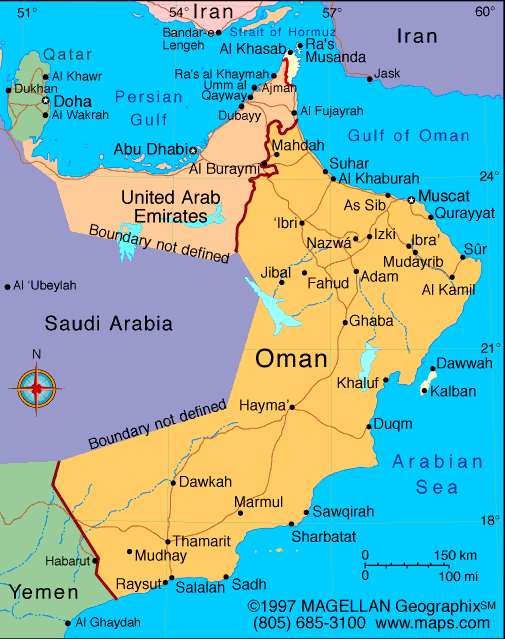OMAN

Geography: Oman is a 1,000-mile-long (1,700 km) coastal plain at the southeast tip of the Arabian Peninsula lying on the Arabian Sea and the Gulf of Oman. It is bordered by the United Arab Emirates, Saudi Arabia, and Yemen. The country is the size of Kansas.
Government: Absolute monarchy.
History: Arabs migrated to Oman from the 9th century BC onward, and conversion to Islam occurred in the 7th century AD Muscat, the capital of the geographical area known as Oman, was occupied by the Portuguese from 1508 to 1648. Then it fell to Ottoman Turks, but in 1741, Ahmad ibn Sa'id forced them out, and the descendants of Sultan Ahmad rule Oman today.
Ahmad expanded his empire to East Africa, and for a time the Omani capital was in Zanzibar. After 1861, however, Zanzibar fell from Omani control.
The sultans and imams of Oman clashed continuously throughout the 20th century until 1959, when the last Ibadi imam was evicted from the country. In a palace coup on July 23, 1970, the sultan, Sa'id bin Taimur, who had ruled since 1932, was overthrown by his son, Qabus ibn Sa'id, who promised to establish a modern government and use newfound oil wealth to aid the people of this very isolated state. Oman joined the Arab League and the United Nations in 1971.
A long border dispute with Yemen was resolved in Oct. 1992; in 1997, the countries agreed to new maps defining the border.
In 1997, Sultan Qabus granted women the right to be elected to the country's consultative body, the Shura Council (Majlis al-Shura). In 2003, the sultan extended voting rights to everyone over 21; previously, voters were selected from among the elite, and only about a quarter of the population was allowed to vote.
Government: Absolute monarchy.
History: Arabs migrated to Oman from the 9th century BC onward, and conversion to Islam occurred in the 7th century AD Muscat, the capital of the geographical area known as Oman, was occupied by the Portuguese from 1508 to 1648. Then it fell to Ottoman Turks, but in 1741, Ahmad ibn Sa'id forced them out, and the descendants of Sultan Ahmad rule Oman today.
Ahmad expanded his empire to East Africa, and for a time the Omani capital was in Zanzibar. After 1861, however, Zanzibar fell from Omani control.
The sultans and imams of Oman clashed continuously throughout the 20th century until 1959, when the last Ibadi imam was evicted from the country. In a palace coup on July 23, 1970, the sultan, Sa'id bin Taimur, who had ruled since 1932, was overthrown by his son, Qabus ibn Sa'id, who promised to establish a modern government and use newfound oil wealth to aid the people of this very isolated state. Oman joined the Arab League and the United Nations in 1971.
A long border dispute with Yemen was resolved in Oct. 1992; in 1997, the countries agreed to new maps defining the border.
In 1997, Sultan Qabus granted women the right to be elected to the country's consultative body, the Shura Council (Majlis al-Shura). In 2003, the sultan extended voting rights to everyone over 21; previously, voters were selected from among the elite, and only about a quarter of the population was allowed to vote.

Map of Oman
Sultan:
Qabus ibn Sa'id (1970)
Total area: 82,031 sq mi (212,460 sq
km)1
Population
(2014 est.): 3,219,775 (growth rate: 2.06%); birth rate: 24.47/1000;
infant mortality rate: 14/1000; life expectancy: 74.97
Capital (2011 est.):
Muscat, 743,000
Monetary unit: Omani
rial
National
name: Saltanat Uman
Languages:
Arabic (official), English, Baluchi, Urdu,
Indian dialects
Ethnicity/race:
Arab, Baluchi, South Asian (Indian, Pakistani,
Sri Lankan, Bangladeshi), African
Religions:
Muslim (official; majority are Ibadhi, lesser numbers of
Sunni and Shia) 85.9%, Christian 6.5%, Hindu 5.5%, Buddhist 0.8%, Jewish
note: approximately 75% of Omani citizens, who compose almost 70% of
the country's total population, are Ibadhi Muslims; the Omani government
does not keep statistics on religious affiliation (2013)
National Holiday:
Birthday of Sultan Qaboos, November 18
Literacy rate: 86.9% (2010 est.)
Economic summary: GDP/PPP (2013 est.):
$94.86 billion; per capita $29,800. Real growth rate: 5.1%.
Inflation: 1.6%. Unemployment: 15% (2004 est.).
Arable land: 0.1%. Agriculture: dates, limes, bananas,
alfalfa, vegetables; camels, cattle; fish. Labor force: 968,800
(2007 est.); agriculture n.a., industry n.a., services n.a.
Industries: crude oil production and refining, natural and
liquefied natural gas (LNG) production; construction, cement, copper,
steel, chemicals, optic fiber. Natural resources: petroleum,
copper, asbestos, some marble, limestone, chromium, gypsum, natural
gas. Exports: $56.22 billion (2013 est.): petroleum,
reexports, fish, metals, textiles. Imports: $30.75 billion
(2013 est.): machinery and transport equipment, manufactured
goods, food, livestock, lubricants. Major trading partners:
China, South Korea, Japan, Thailand, UAE, U.S., Singapore, India
(2012).
Communications: Telephones:
main lines in use: 305,000 (2012); mobile cellular: 5.278 million (2012).
Broadcast media: 1 state-run TV broadcaster; TV stations
transmitting from Saudi Arabia, the UAE, and Yemen available via
satellite TV; state-run radio operates multiple stations; first private
radio station began operating in 2007 and 2 additional stations now
operating (2007). Internet hosts: 14,531 (2012). Internet users: 1.465 million (2009).
Transportation: Railways: 0 km.
Highways: total: 60,240 km; paved: 29,685 km (including 1,943 km
of expressways); unpaved: 30,545 km (2012). Ports and harbors: Mina' Qabus, Salalah, Suhar. Airports: 132
(2013).
International disputes:
boundary agreement reportedly signed and ratified with UAE in
2003 for entire border, including Oman's Musandam Peninsula and Al
Madhah enclave, but details of the alignment have not been made public.
-------------------- o --------------------
No comments:
Post a Comment